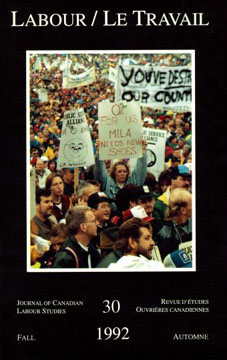Abstract
During the early 1920s the Communist Party of Canada (CPC) established a significant presence in industrial Cape Breton, based on support from the militant minority of the district's unusually combative coal mining union, UMWA District 26, and its charismatic Secretary-Treasurer James Bryson McLachlan. The latter's early recruitment was centrally important in forging what would become enduring political links with rank-and-file militants; it was largely thanks to McLachlan that, through all the ebb and flow of social context and human agency, the party survived the vicissitudes of deteriorating structural conditions and its own tactical blunders (most notably during the "third period"), to emerge in the mid-1930s with genuinely optimistic prospects. The Scot did not always lead his forces well: like many revolutionary contemporaries his bolshevik temperament was ill-suited to defensive struggle. He nevertheless perceived, and to a limited extent acted upon, the need to construct a defensive communist counter-culture within the struggle for workers' power in the community and the workplace. The embodiment of bolshevik intransigence, McLachlan offered a fixed rallying-point for "class fighters," especially those who shared his internationalist perspective. Having drawn a new layer of younger militants towards him in 1934-35 — and having seen off the CCF in the process - McLachlan could claim to have placed the CPC in its strongest position for a decade.
Résumé
Au début des années 1920, le Parti communiste du Canada (PCC) s'implante de façon significative dans les centres industriels du Cap Breton grâce à l'appui d'une minorité militante au sein du syndicat régional des mineurs de charbon, l'UMWA District 26, et de James Bryson McLachlan, son charismatique secrétaire-trésorier. L'enrôlement rapide de McLachlan dans le PCC se révéla capital à la formation de liens politiques durables avec les militants de la base; c'est surtout grâce à McLachlan que le parti survécut aux vicissitudes de la détérioration des conditions structurelles régionales et de ses propres erreurs de stratégie (particulièrement au cours de la "troisième période"), pour pouvoir enfin envisager l'avenir du parti avec un optimisme véritable au milieu des années 1930. Tout comme plusieurs révolutionnaires contemporains dont le tempérament bolcheviste supportait mal une stratégie défensive, le leader écossais n'a pas toujours su bien mener ses forces. Il a néanmoins reconnu le besoin et parfois même contribué à l'essor d'une contre-culture communiste défensive dans la lutte pour le pouvoir ouvrier au sein de la communauté et du milieu de travail. Ayant attiré dans son orbite une nouvelle génération de militants, tout en abandonnant le part: CCF, McLachlan pouvait se féliciter d'avoir placé le PCC, en 1934-35, dans sa plus forte position politique depuis une décennie.
